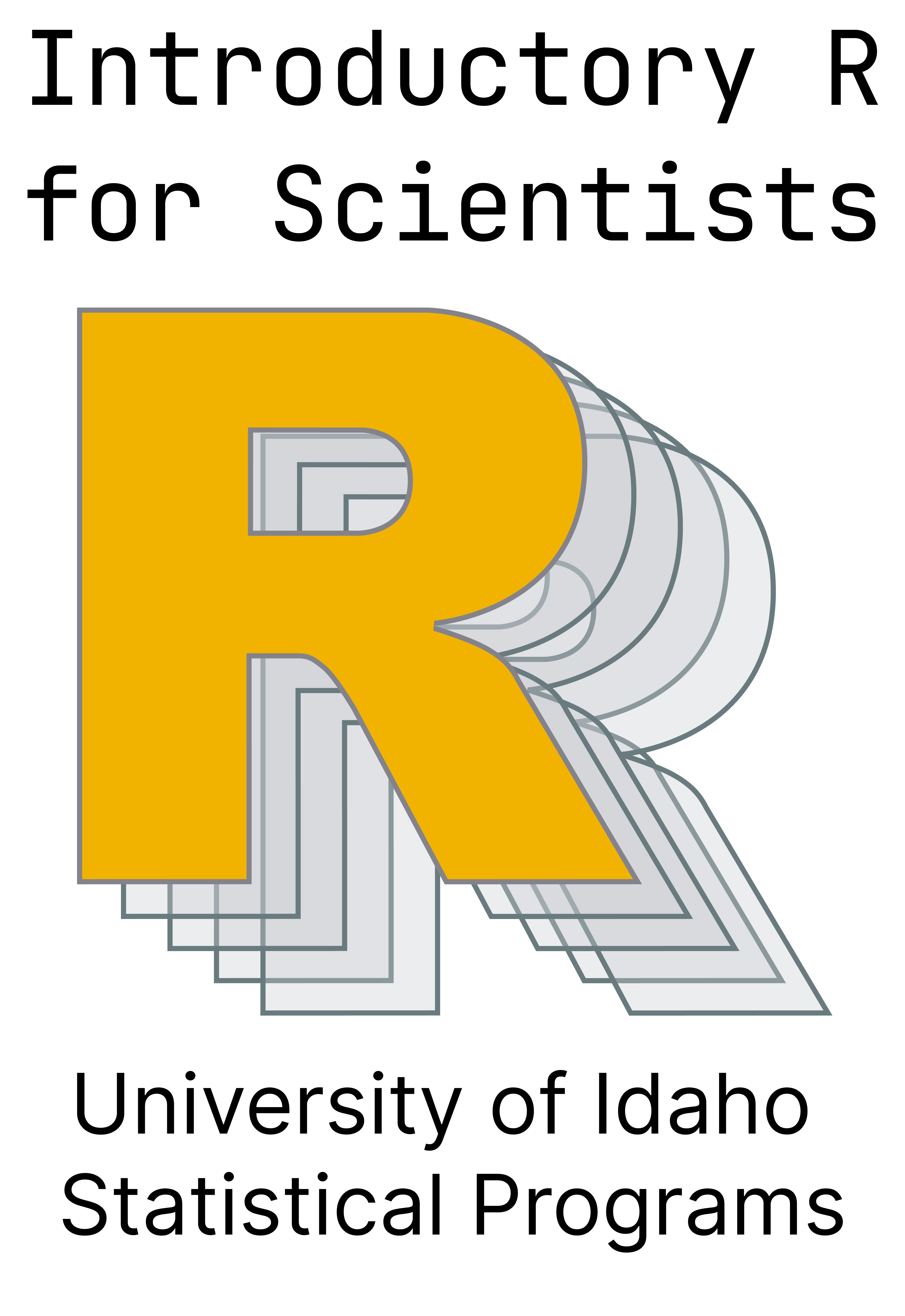x <- 1:10
y <- ifelse(x < 5, NA, x)Repeating Actions in R
At the end of this lesson, you should:
- know how to use
apply()to iterate across a data frame - know to use
lapply()to interate across a list - know the structure of purrr functions for iterating across different object types
- know when and how to construct a
forloop
Repeating operations across a vector
Reminder: a vector is an object with a length attribute composed of items each of the same class. It can have a name attribute (not required)
ifelse(test, action-if-yes, action-if-no)The ‘test’ should be an R function that will return a TRUE or FALSE, e.g.
is.na(),is.numeric()Vector example
- Vector example inside a data.frame
data(storms, package = "dplyr")
storms$category_simple <- ifelse(storms$wind <= 50, "small", "big")Repeating operations across a data frame
apply()a simple handy function to repeat things across a data.frame (or tibble, or matrix)This operation is vectorised, meaning all processes proceed simultaneously
Across rows
storm_num <- select_if(storms, is.numeric)
apply(storm_num, 1, median, na.rm = TRUE)- Across columns
storm_num <- select_if(storms, is.numeric)
apply(storm_num, 2, median, na.rm = TRUE)Special R functions for rows and columns
- These functions are very, very fast
- They are not forgiving of non-numeric data
rowSums(); colSums()
rowMeans(); colMeans()library(dplyr); data("storms")
Attaching package: 'dplyr'The following object is masked _by_ '.GlobalEnv':
stormsThe following objects are masked from 'package:stats':
filter, lagThe following objects are masked from 'package:base':
intersect, setdiff, setequal, unionstorms %>% select_if(is.numeric) %>% colMeans(na.rm=TRUE) year month
2002.754364 8.705635
day hour
15.732303 9.100937
lat long
27.005763 -61.560086
category wind
1.895690 50.049393
pressure tropicalstorm_force_diameter
993.484465 147.869327
hurricane_force_diameter
14.920698 NA values
- I often get the question “how can I replace”NA” across my entire data object?”
NAis a reserved word in the R language referring to missing data. Often the best way to handle how missing values from your data are handled is to specify that when the file is read in. Check the documentation for your import function, e.g.read.csv(..., na.string = "...").- To do a global replacement of
NAwith another value, usetidyr::replace_na() - To do a global replacement of another value with
NA, this can be handled in the import, or usedplyr::na_if()
Repeating operations across a list
😍😍😍😍😍 lapply() 😍😍😍😍😍
- Vectorised over lists
- If you can express one aspect of your operation as a list, this can probably work for you!
- Downside: everything comes back as a list (it takes an effort to convert this into a more exportable form)
- It uses very simple notation:
lapply(list, some_function)- Example
integers <- sample(1:100, 200, replace = TRUE)
thrice_int <- lapply(integers, function(x) x*(c(1,2,3)))I’m very fond of this for doing complex repeat operations. Perhaps I have a group of experiments, all with identical experimental design, that each need to be analyzed the same. Using a list can accomplish this efficiently.
lapply() flotsam & jetsam
- Dealing with lists can be challenging: they follow different rules; they typically require lots and lots of indexing to extract content. And you usually can’t write a list straight to file like a data.frame.
sapply()is just likelapply(), except it tries to simplify to common R data objects - a matrix or array. This works if the return data is one row.dplyr::bind_rows()can concatenate data.frames better thanrbind().- Getting things out of a list and into the desired format can be one of the most challenging aspects of working with
lapply()(bonus: it makes you understand R data types really well!). - purrr to the rescue!
purrr for repeat operations
purrr does all of the hard work of iteration plus conversion of output to the object type you want! It works on data structures of all types: vectors, data frames and lists.
library(purrr)
mtcars %>%
split(.$cyl) %>%
map(~ lm(mpg ~ wt, data = .x)) %>%
map_dfr(~ as.data.frame(t(as.matrix(coef(.))))) (Intercept) wt
1 39.57120 -5.647025
2 28.40884 -2.780106
3 23.86803 -2.192438purrr is complicated! Make use of the cheatsheet].
Base/Tidyverse equivalents
| base functions | tidyverse equivalent |
|---|---|
lapply() sapply() vapply() |
purrr package |
mapply() |
purrr::pmap() |
tapply() |
dplyr::group_by() %>% dplyr::summarise() |
replicate() |
purrr:rerun() |
ifelse() |
dplyr::case_when() |
The oft-abused for
A for loop:
for (i in thingy) {
do_something()
}I see things like this frequently:
x <- LETTERS[1:10]
for (i in x) print(i)
# same as sapply(x, print)Or worse:
for (i in item1) {
for(j in item2) {
here_we_go(...)
} }Optimal use of for
- Better usage of
foris when you require the previous value(s) to proceed through the loop - pre-allocation of your vector/data.frame/list/etc will result in faster code
# vector pre-allocation
f <- c(0, 1, rep(NA, 98))
f[1:10] [1] 0 1 NA NA NA NA NA NA NA NA# Fibonacci sequence
for (i in 3:100){
f[i] = f[i-1] + f[i-2]
}
f[1:10] [1] 0 1 1 2 3 5 8 13 21 34Traditional control flow
- These are standard control variables that exist across many languages to repeat operations.
- These are not vectorized; they only work with a single input at time.
if
else
for
while
next
break- Note that these are reserved words in the R language; you cannot use these words for any other purpose in the R language than what they are designed to do (no function masking is possible).
Teaching how to use these traditional control flow variables is beyond an introductory course in R. However, you can learn more about it here and Introduction to R manual.
Understanding how to do repeat operations in R often requires a strong understanding of the underlying data structures we are trying to perform those operations on. This aspect of R, sometimes called “data conditioning” can be one of the most challenging aspects of using R. When writing repeat operations, check back on Lessons 3 and 4 that address basics of data types and data structures if you are having trouble.
